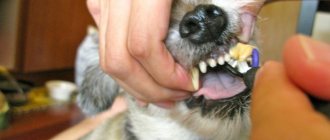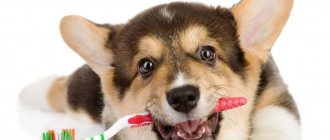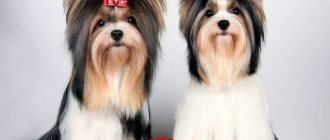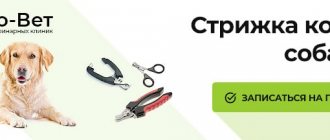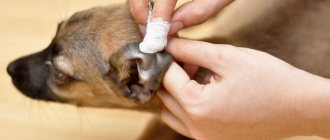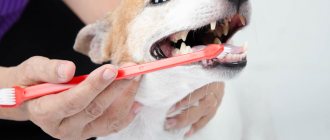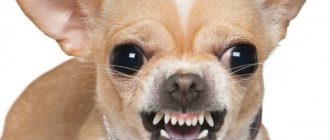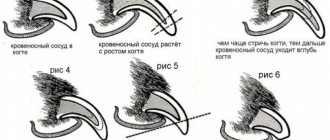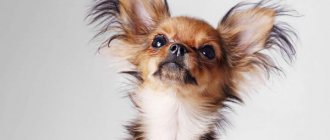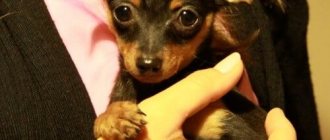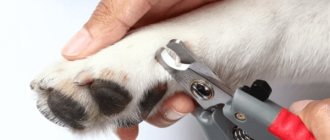Hygiene procedures for dogs are no less important than for people. The question of how to properly care for a dog’s ears sometimes arises not only among beginners, but also among experienced dog breeders. This point is especially important if the pet’s ears are long and not cropped, and the hair near the auricle is quite thick and shaggy. All these factors provoke the accumulation of secretions. The question arises: is it really more difficult to clean a dog’s ears than it is for people? How and with the help of what available means can this be done correctly? All doubts will disappear once and for all if you understand the nuances of the procedure and the intricacies of the physiology of our four-legged friends.
Why do you need to clean your dog's ears?
Pets need to clean their ears, if only for the reason that in the absence of regular hygiene procedures, various foreign bodies - bacteria, fungus - appear in the ears. As a result, pets may develop otitis media.
Caring for your dog's ears is not difficult - especially if you have experience. To minimize the risk of possible fungal and bacterial diseases and reduce the likelihood of inflammatory processes in the ear, it is necessary to periodically examine your pet. This simple event helps to avoid health problems in dogs.
Another indication for washing and cleaning dogs’ ears is the parasite Otodectes cynotis, a specific mite that parasitizes the external auditory system of four-legged animals. The signs of ear mites are similar to those of otitis media. But there is a difference: if a dog has a “squelching” sound in his ear, there cannot be a parasite there, since this insect lives exclusively in an environment with 100% air access. The presence of infection is indicated by dry black spotty discharge in the ear. Treatment is carried out with acaricidal drugs, but before this the pet’s ears are thoroughly cleaned using the technology described below.
What is important for the owner to know
Yorkies are very fragile creatures. On average, this dog breed lives from 12 to 14 years. An adult animal should weigh no more than 3170 grams.
The Yorkshire Terrier is very friendly and can quickly form friendships with people or animals. He is devoted to his owner, an attentive listener. It has long been known that Yorkies have a positive effect on the psyche.
This breed of dog does not shed and does not have a specific odor.
If you buy a Yorkshire Terrier puppy without the help of a specialist, you need to pay attention to the following features:
- The “calling card” of a real Yorkshire Terrier is its brand.
- The legs should be straight and the back should be level.
- The wool and skin are clean; if the wool looks like cotton wool, you will have to suffer with it.
- The eyes, nose and ears should not be damaged or inflamed.
- There should be six teeth below and six below, a scissor bite.
How often to walk
A Yorkie puppy should be taught to walk gradually, first he is taken outside in his arms and walked for a short time, after a while you can start carrying him in a bag. And only when he gets used to it, you can put the puppy on the grass for a while if the weather is good outside.
You should only walk with this curious dog using a roulette wheel. A walk of about an hour a day is enough to satisfy your Yorkie's need for activity.
Although Yorkies have long hair, they do not provide warmth due to the lack of undercoat. Therefore, it is better to dress your dog in special overalls and shoes for walks.
What physical activity does a dog need?
Your Yorkie should receive some physical activity every day. Games are suitable for this, so you need to make sure that the dog plays and runs as often as possible.
If you don't let it discharge, your Yorkie will start misbehaving at home: tearing wallpaper, chewing things and doing all sorts of mischief.
What troubles can happen to a Yorkshire Terrier?
Yorkies are brave, curious and fearless. Recklessly brave puppies, chasing something, can jump out onto the road or fall under the feet of a person or the wheels of a stroller.
Therefore, in order to avoid troubles, it is imperative to control their movement.
It is imperative to teach the puppy basic commands, as without them you can lose the puppy. They are easy to train, but this requires a strong owner, as these dogs are very ambitious.
How and how to clean a dog's ears at home
Cleaning your ears yourself at home is necessary regularly throughout your pet’s life. To achieve the effect, experts advise using veterinary remedies to remove wax from dogs’ ears or homemade natural herbal decoctions:
- for example, lotions from a veterinary pharmacy dissolve dirt and earwax, which is removed by massaging, with a damp cloth or shaking the ears by the dog itself;
- For four-legged long-eared breeds, it is recommended to use a special powder that has a drying effect: first clean the auricle with the product, and then apply the powder;
- herbal decoctions have an antiseptic and wound-healing effect (decoction of string, birch buds, calendula), they are used in the same way as lotions.
Regular ear care is not at all difficult and does not require the help of specialists. The procedure must be carried out carefully and slowly. You should prepare everything you need in advance: cotton wool, cotton swabs or cotton pads (to dry the ears after using lotions), wet wipes or disposable handkerchiefs - directly for cleaning the auricle, special products for caring for dogs’ ears (lotion, chlorhexidine, peroxide, powder) .
How to do this correctly?
- The first steps are to gain the dog's trust and allow him to relax as much as possible. It is important that the dog does not become nervous.
- We straighten the auricle and clean the entire surface of the outer ear with a soft damp cloth (if it is a hanging ear, especially carefully).
- We fill the ear canal with a special product (preheated in a water bath to room temperature).
- We massage the outside of the ear for a few seconds - the slurping sound inside the pet’s ear will tell you that an active process of softening the wax is underway.
- We clean the folds of the ear using cotton swabs.
- We carefully dry the visible parts of the ear with a cotton pad or cotton wool - this is the final stage in caring for the dog’s ears.
The owner of a four-legged friend should be attentive to the skin surfaces of the outer ear - if redness and ulcers are noticeable on the ear, you should carefully wipe the irritation with a cotton pad with any anti-inflammatory ointment (zinc or Levomekol), to which boric acid is added on the tip of a knife.
It is important to know: if the pet squeals and behaves aggressively after the start of treatment, you should stop cleaning. It is possible that the dog’s ears have deep wounds or damage; this will require the intervention of a veterinarian.
If the dog is healthy, then experts recommend not to perform any therapeutic procedures on it at all. It is enough to monitor hygiene and not lose sight of the dog’s mood - neglected ears will inevitably lead to illness, which will immediately affect the dog’s appearance and behavior.
How to brush your Yorkshire Terrier's teeth
A Yorkshire Terrier needs to brush its teeth at least twice a week, or even better, every day. There are many devices for this procedure: toothbrushes, teeth-cleaning toys and bones. The choice is quite wide. You should not immediately start with brushing your teeth; first you need to prepare your dog. First, for the first few days, simply massage your Yorkie's gums with your finger, then add toothpaste specially formulated for animals, since fluoride is harmful to dogs. If the dog is used to it, you can switch to a brush, do it slowly with a small amount of paste, without causing pain to the dog. After brushing, reward your dog with some kind of treat. A more convenient way to clean teeth would be bones and toys, and dogs love them so much.
The above methods of care are the most basic and important. By following them, you can rest assured that your dog will be well-groomed, neat, joyful and beautiful.
Is it possible to clean a dog's ears with chlorhexidine?
This natural antiseptic, like hydrogen peroxide, is very often used in everyday life and is often used as a simple means for cleaning dogs’ ears. They actually cauterize wounds, treat cuts, and often disinfect the ears of pets.
Veterinary experts strongly recommend using the drug in exceptional cases: when, during cleaning, the dog owner notices symptoms of skin inflammation. In this case, you can drop a few drops of chlorhexidine into the ear and massage lightly. Next, the pet definitely requires examination and full treatment. The antiseptic is not intended for prevention - it dries the skin and, if used uncontrolled, can cause allergic reactions.
How to care for a newly purchased puppy
Even before the puppy arrives, you need to take care of the necessary care items and prepare the place. In a new home, the terrier may be frightened by the new environment, but gradually he will begin to get used to it and master the territory.
What to buy for a puppy
It is better to buy all products for the maintenance and care of the Yorkshire Terrier in pet stores or at large exhibitions.
For York you will need:
- enclosure (to create a cozy and safe place in the puppy’s home);
- bed;
- carrying bag;
- collar with leash and tape measure;
- bowls, at least two pieces;
- feeder and drinking bowl (necessarily heavy, ceramic or earthenware);
- latex and edible toys made from veins (bones, balls, squeakers);
- specialized cosmetics (shampoos, balms, sprays);
- Terry towel;
- combs of several types: metal with a comfortable handle and frequent rounded teeth; massage brushes;
- papillots with elastic bands;
- small scissors with rounded ends, which are convenient for trimming the hair on the ears and between the toes;
- nail clippers or nail clippers;
- file for sharpening claws;
- various clothes;
- bows, hairpins and various accessories for creating hairstyles
Prepare your apartment for the arrival of a dog
For the puppy, you need to secure the quietest place in the house. Do not give it a place where drafts are possible. You cannot assign the puppy a place near the radiator, in the corridor where people often walk.
Remove all small toys and things from the house that an inquisitive dog might chew or swallow. It is better to purchase a special playpen, the dog will be safe in it, but do not put it in a dark corner. Give your Yorkie a bed to sleep on.
How to prepare a place where the dog will rest?
You can sew a puppy bed yourself by filling it with padding polyester or furniture foam rubber. Removable covers are a must. Specialized stores sell sun loungers with sides or in the shape of a house. Dogs feel more protected on them.
A basket for a Yorkie's sleeping place will not be suitable, since he will definitely want to chew on it - “to taste it.”
How to train to the tray
It’s not difficult to train a Yorkie to sit on a tray, but at first you will have to suffer a little. Be patient, if you scold and punish him, you can upset the dog’s psyche.
Little Yorkies relieve themselves after eating and sleeping. This is the time to plant them. Stand in front of him until he empties. After this, be sure to praise him. Soon the dog will learn to cope with this matter on its own.
And if your pet continues to misbehave at home, then read our detailed recommendations on how to wean him off it.
How to clean a dog's ears with otitis media
A healthy dog's ears are unlikely to need to be cleaned with rinsing. Sometimes veterinarians prescribe rinsing with special disinfectant solutions for ear congestion or wax plugs. This manipulation is indicated for ear inflammation that occurs with purulent exudate. But most often, in case of a serious course of the disease, all similar procedures are carried out by a specialist.
How to clean a dog's ears with otitis media using rinsing?
- First you need to prepare a medicinal solution (peroxide or furatsilin - prepared according to the recommendations of a veterinarian) to rinse the auditory cavity. The temperature of the liquid should not exceed 35-36 degrees.
- You need to take a regular medical syringe, always unused, a convenient volume of 20 ml, remove the needle.
- Take about 2 ml of solution and fix the dog’s head to one side.
- Place the syringe shallowly on the side of the back wall of the ear and slowly inject the liquid solution - 1 ml in stages.
- Cover your ear with a small towel or disposable scarf and turn your head over to the opposite side.
- Return the animal's head to its original position, and use a cotton swab to wipe the area near the ear canal, removing accumulations of pus from the outside.
After the procedure, the pet is contraindicated to go outside in the cold season for 6 hours; in the summer you can limit it to 2 hours.
Yorkie ear trim
You can trim the hair on your ears using different devices: scissors, an electric clipper, a razor. Which one is more convenient?
Ears are cut when the hair on the ears grows by 3-5 mm, approximately, we begin to cut ears from 1-1.5 months. age. Hair is removed from the top 1/3 of the eyelet fabric, on both sides, using the following scheme:
Please note that the back of the fabric is cut in the shape of a diamond - this ensures that the beautiful fringes on the ears are preserved, and the ears are light in weight (which is important for their placement). Use a razor to remove hair from the top of the ear and from the inside. We use a dry machine on dry wool (without special products or moisture) - we shave the wool with movements against hair growth. Afterwards it will be convenient to make an even contour.
I suggest watching a good video on how to properly trim the fur on a Yorkie's ears.
Diagnosis and treatment
Veterinarians do not recommend treating a sick animal yourself with such symptoms , since the signs are consistent with too many diseases. To make the correct diagnosis and select therapy, a dog who comes in with similar problems is carefully examined in several ways:
- Scraping damaged skin.
- General blood analysis.
- Blood chemistry.
- X-ray if there is a suspicion of a foreign body or neoplasm.
Only after receiving the results of all the tests will the veterinarian be able to make an accurate diagnosis and identify the root cause of what happened, and then begin to treat it.
It is extremely important not only to get rid of the symptoms, but also to remove their cause, because otherwise the inflammation will recur regularly.
Basic rules for keeping a Yorkie
To prevent diseases, do not forget to examine the terrier daily; if there is any abnormality, the puppy must be shown to a veterinarian.
A normal, standard, healthy Yorkshire Terrier typically weighs between 2 and 3 kg. The temperature, which is measured through the anus, should be 38-39 degrees.
What are the problems and diseases?
In the process of breeding a Yorkie, the following diseases are most often noticed:
- Dermatitis, alopecia and other skin diseases. With dermatitis, tumors and fever appear. Alopecia causes patchy hair loss, usually on the scalp.
- Eye diseases such as cataracts and glaucoma. They can appear due to improper care, after which the dog’s eyes become cloudy.
- Displacement of the joints of the limbs. Patella dislocations. They are usually congenital.
- Diseases of the joints of the limbs, fractures, etc. Because of them, the dog begins to limp.
- Kidney disease, with frequent urination and thirst. The dog is losing weight, although her appetite remains good.
- Allergy.
- Non-closure of the fontanel. By the time the dog is one year old, it should be closed.
- Spasm of the pharynx, which makes breathing difficult, leading to suffocation.
- Hernia.
When to get vaccinated?
Vaccinations will help keep your pet healthy. The first vaccination is given at 6 weeks, then repeated after two or four weeks. The next vaccination is scheduled for the year when all the teeth are replaced.
Then one vaccination is given per year. Two weeks before vaccination, it is necessary to carry out procedures to expel worms.
Grooming
All Yorkies have long, beautiful hair that requires constant care. It is necessary to comb the fur. You can give your dog a model haircut, but most owners like to do their pet’s hair themselves.
